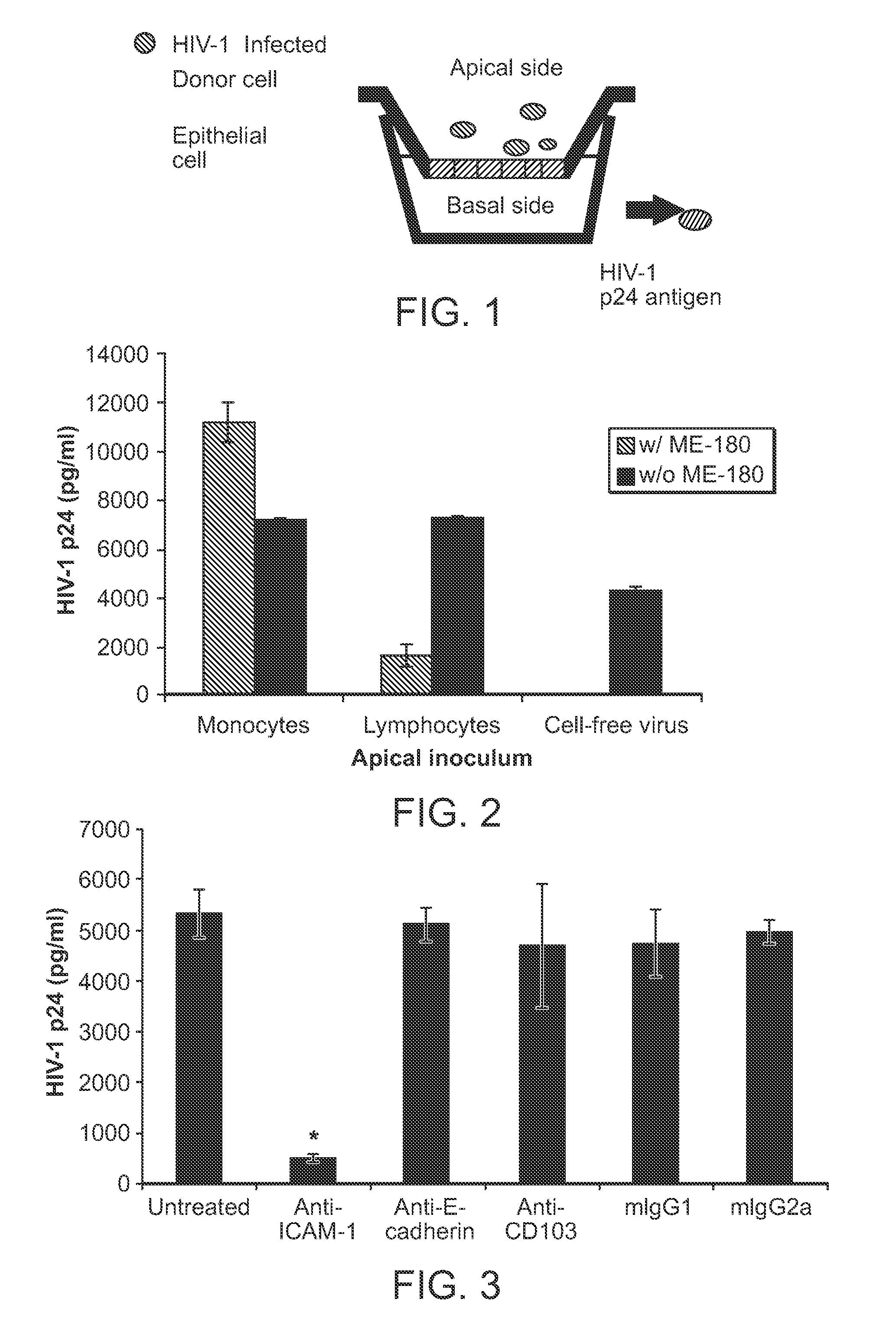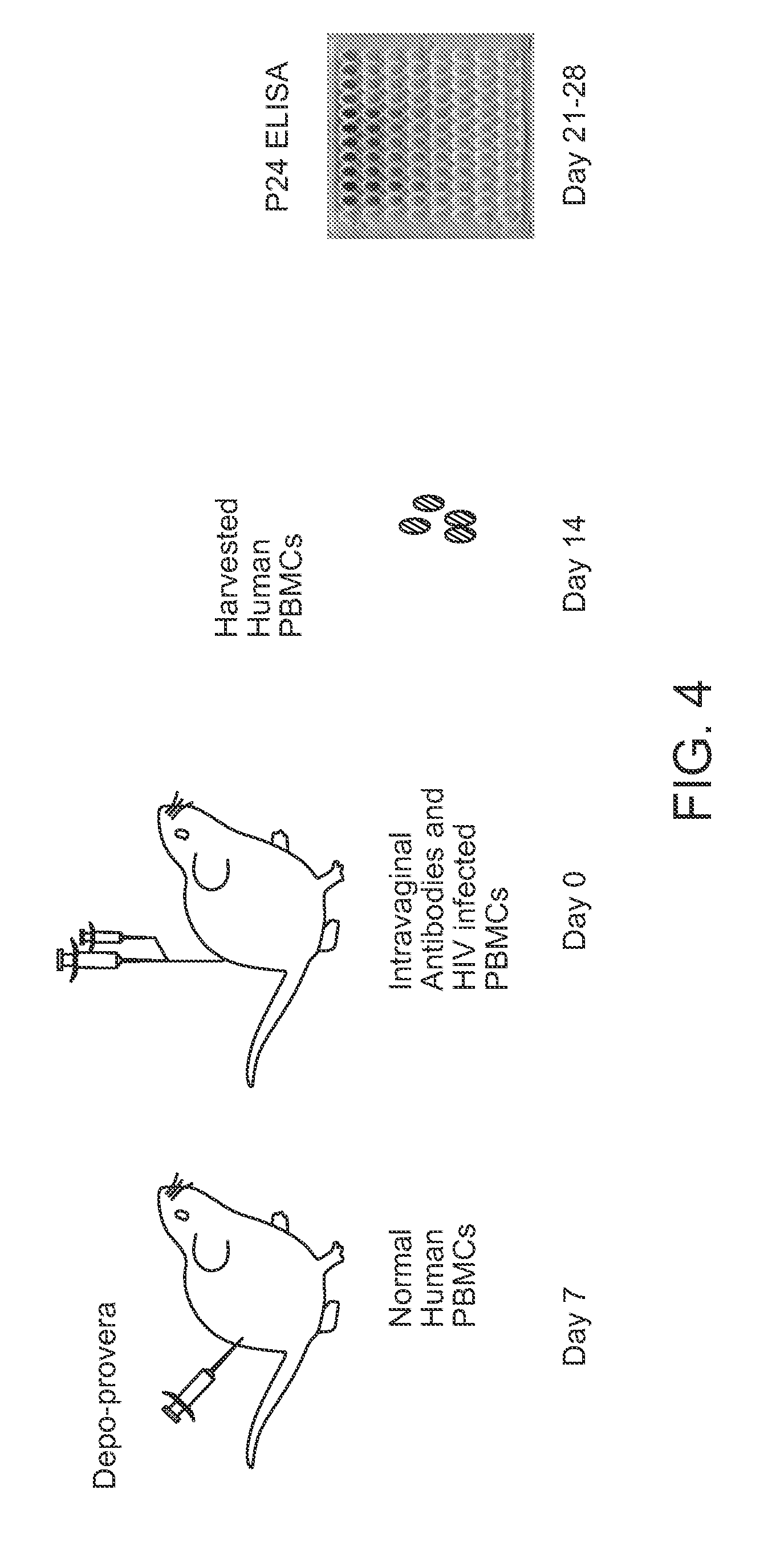Use of camelid-derived variable heavy chain variable regions (VHH) targeting human cd18 and icam-1 as a microbicide to prevent hiv-1 transmission
a technology of heavy chain variable and camelid, which is applied in the field of camelid-derived variable heavy chain variable regions (vhh) targeting human cd18 and icam-1 as a microbicide to prevent hiv-1 transmission, can solve the problems of increased transmission observed with the use of cellulose sulfate, high viral mutation frequency, and unexpected effects, so as to reduce the number of infected cells, increase the t-cell count, and reduce the concentration of virions
- Summary
- Abstract
- Description
- Claims
- Application Information
AI Technical Summary
Benefits of technology
Problems solved by technology
Method used
Image
Examples
example 1
The Role of Cell-Associated Vs. Cell-Free Virus to Transmit HIV-1 Across an Epithelial Barrier
[0151]Initial studies were conducted using a transwell system (FIG. 1), in which free virus or cell-associated virus was placed in the upper of two chambers of a tissue culture system, and in which the two chambers are separated by a nylon mesh. A cervical epithelial cell line has been grown to confluence on the mesh as measured by electrical resistance across the chambers. This system permits study of the movement of virus across epithelium to the interepithelial or submucosal dendritic cells in which initial infection of host cells is established (Hu et al, J Virol 74:6087-6095 (2000); and Spira et al., J Exp Med 183:215-225 (1996)). Infected cells or cell free virus are placed in the apical chamber with or without reagents that might inhibit transmission. After 24 hours, a sample from the lower chamber is examined for the presence of HIV-1 p24 antigen.
[0152]One of the advantages of this ...
example 2
Ability of Antibodies Targeting Molecules Involved in Cell Translocation Across Epithelia to Block HIV-1 Transmission
[0154]Because of the potential importance of cell-associated transmission of virus across epithelium, the ability of antibodies targeting ligands that were potentially involved in that process to block transmission in HIV-1 infected cells was evaluated using the transwell assay. All of the antibodies were derived from mouse hybridomas, purified on Protein G columns, and protein concentrations were determined using the Bio-Rad protein assay (Hercules, Calif.). As seen in FIG. 3, only antibody to ICAM-1 significantly reduced transmission in this system.
example 3
Ability of Anti-ICAM-1 to Block Vaginal Transmission of Cell-Associated HIV-1 in a Mouse Model
[0155]Because mice cannot be infected with HIV-1, the inventors developed a vaginal transmission model in which CB.17 scid / scid immunodeficient mice receive intraperitoneal transplantation of human peripheral blood mononuclear cells and then are challenged by the vaginal route with HIV-1 infected PBMC or macrophages (HuPBL-SCID mouse model, FIG. 4). In order to enable transmission in this system, the mice must first be pre-treated with progesterone, which converts the stratified squamous epithelium of the vagina into the single-layered columnar epithelium typical of the endocervix, thought to be a “hot zone” of HIV-1 transmission (Anderson et al., N. Engl. J. Med 309:984-985 (1983)). At the time of progesterone treatment 5×107 normal uninfected, unstimulated PBMC are placed into the peritoneal cavity. One week later, mice receive 1×106 PBMC or macrophages by atraumatic intravaginal inoculat...
PUM
 Login to View More
Login to View More Abstract
Description
Claims
Application Information
 Login to View More
Login to View More - R&D
- Intellectual Property
- Life Sciences
- Materials
- Tech Scout
- Unparalleled Data Quality
- Higher Quality Content
- 60% Fewer Hallucinations
Browse by: Latest US Patents, China's latest patents, Technical Efficacy Thesaurus, Application Domain, Technology Topic, Popular Technical Reports.
© 2025 PatSnap. All rights reserved.Legal|Privacy policy|Modern Slavery Act Transparency Statement|Sitemap|About US| Contact US: help@patsnap.com



